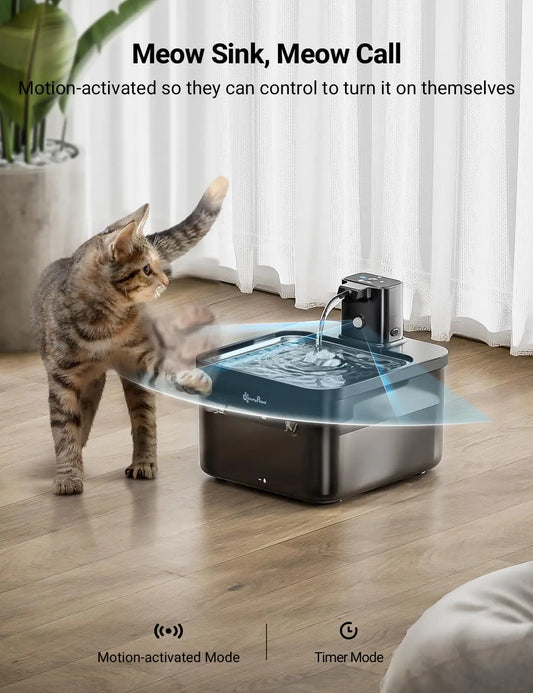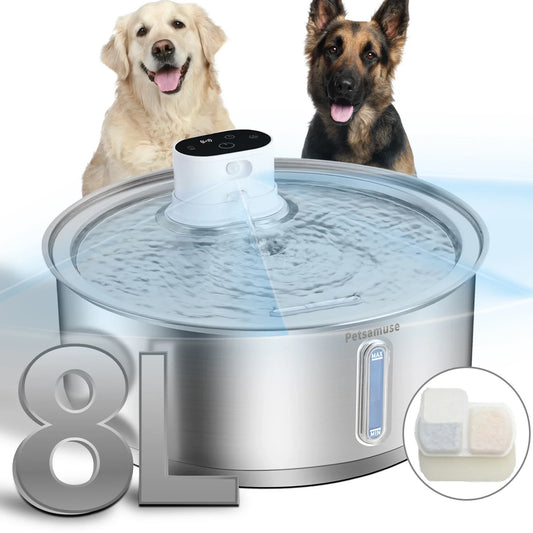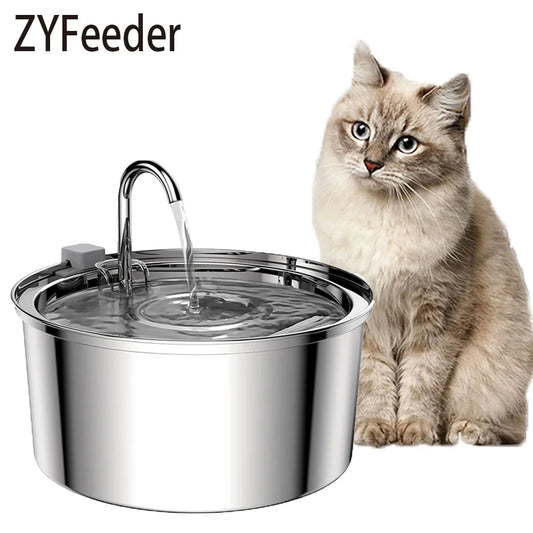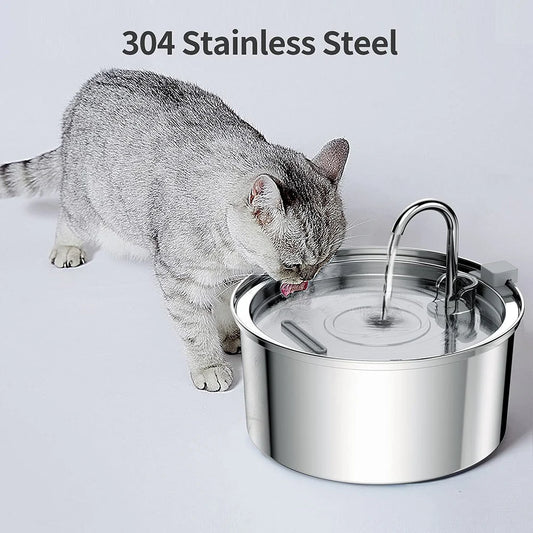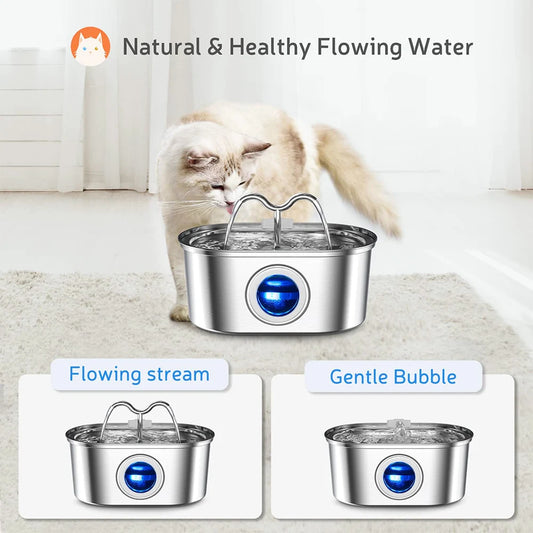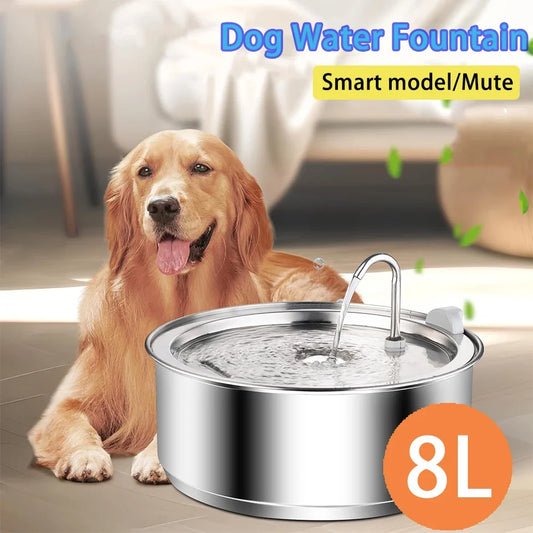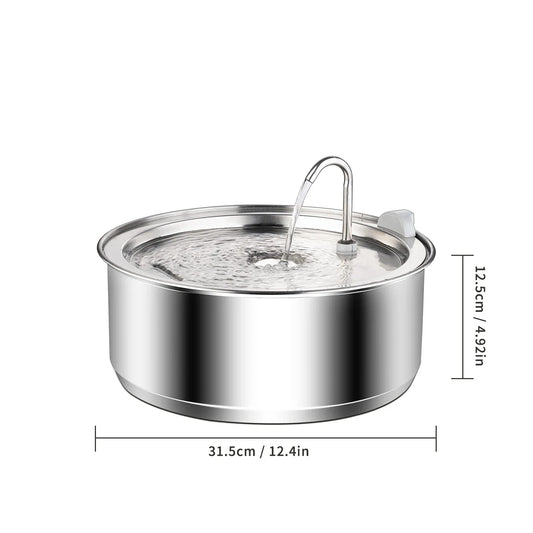Collection: Cat Water Fountain
🐾 Cat Water Fountains – Fresh, Flowing Water for Healthy Cats! 💧
Keep your feline friend happily hydrated with our Cat Water Fountain collection! Designed to attract even the pickiest drinkers, these fountains provide clean, circulating water that supports kidney health and overall wellness.
✅ Whisper-Quiet Pumps | ✅ Multi-Stage Filtration | ✅ Cat-Friendly Designs
From sleek stainless steel to motion-sensor models, we have the perfect fountain to suit every cat’s needs. Make hydration easy—shop now and upgrade your cat’s water routine! 🐱🚰
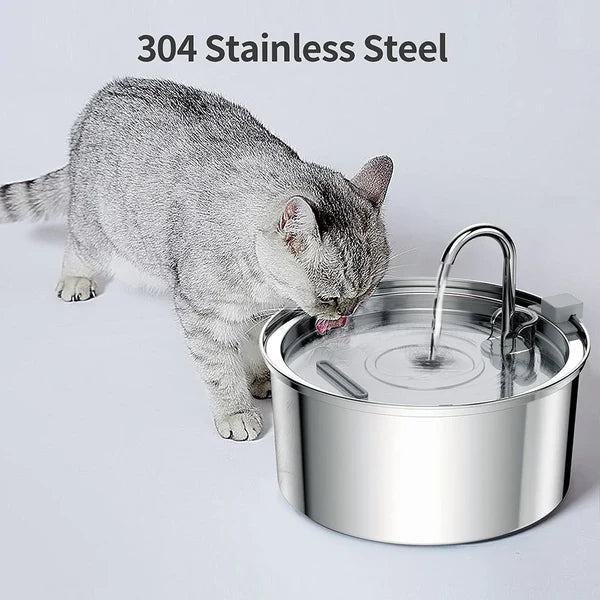
Shop by Category
-
Automatic Stainless Steel Cat Water Fountain
Free ShippingRegular price $98.95 AUDRegular priceUnit price / perSale price$159.95 AUD$98.95 AUDSale -
Automatic Stainless Steel 8L Dog Water Fountain
Free ShippingRegular price From $20.95 AUDRegular priceUnit price / perSale price$29.95 AUDFrom $20.95 AUDSale -
Stainless Steel Pet Automatic Water Fountain
Free ShippingRegular price From $57.95 AUDRegular priceUnit price / perSale price$93.95 AUDFrom $57.95 AUDSale -
Automatic Fountain Drinking Bowl for Cat and Dog
Free ShippingRegular price From $68.95 AUDRegular priceUnit price / perSale price$110.95 AUDFrom $68.95 AUDSale -
Dog Water Fountain Stainless Steel 8L Water Dispenser
Free ShippingRegular price From $121.95 AUDRegular priceUnit price / perSale price$169.95 AUDFrom $121.95 AUDSale
Discover the Best Cat Water Fountains for Healthier, Happier Hydration
Looking for a Cat Water Fountain that keeps your feline friend hydrated, healthy, and engaged? Our premium collection of automatic cat water dispensers is thoughtfully designed to support your cat’s natural drinking instincts, prevent dehydration, and maintain urinary and kidney health—all while adding modern style and function to your home.
Whether you have a senior cat, a picky drinker, or a multi-cat household, these smart fountains are a game-changer for pet parents who want the best in feline hydration.
✅ Why Choose Our Cat Water Fountains?
- Encourages Natural Drinking with Flowing Water
Cats are instinctively drawn to moving water. Our Cat Water Fountains mimic natural springs to encourage hydration—ideal for cats that avoid still water bowls. - Supports Kidney & Urinary Tract Health
Proper hydration is vital for preventing kidney stress and urinary tract infections in cats. These fountains help maintain daily water intake without added effort. - Quiet, Sensor-Activated Designs for Stress-Free Use
Many of our models include ultra-quiet pumps and motion sensors—ensuring water flows only when needed, saving power and reducing noise in your home. - Multi-Stage Filtration for Clean, Fresh-Tasting Water
Each Cat Water Fountain features advanced filters to remove hair, debris, and odors—delivering oxygen-rich, great-tasting water your cat will love. - Durable, Pet-Safe Materials
Crafted from BPA-free plastic or stainless steel, our fountains are easy to clean, resist bacterial buildup, and prevent chin acne common with plastic bowls. - Ideal for Single or Multi-Cat Households
From compact 1.5L models to large-capacity 3L+ designs, we offer the perfect size to suit one cat or a full feline family. - Effortless Maintenance & Refill Systems
Quick-assembly features, water-level indicators, and detachable components make refills and cleaning a breeze for busy pet parents. - Trusted by Cat Owners Australia-Wide
Thousands of Australian cat lovers rely on our fountains to improve their pets’ hydration habits—earning rave reviews for quality, quietness, and convenience.
🚚 Free Shipping on All Cat Water Fountains – Order Now!
Give your cat the gift of fresh, flowing water all day long with our highly rated Cat Water Fountain collection. Shop now and enjoy fast, free shipping Australia-wide!
👉 Support Better Feline Health – Shop Cat Water Fountains Today!
🐱 Cat Water Fountain FAQ – Trusted by Aussie Cat Owners
At PetCareShed, we specialize in high-quality Cat Water Fountains designed to improve feline hydration, reduce health risks, and make life easier for cat parents across Australia. Here are answers to the most commonly asked purchase-related questions from our Australian customers.
1. What is the best cat water fountain to buy in Australia?
The best Cat Water Fountain combines quiet operation, smart filtration, and durable, pet-safe materials. At PetCareShed, we stock a curated selection of top-rated cat fountains—including stainless steel, cordless, and motion-sensor models designed specifically for Aussie homes.
⭐️⭐️⭐️⭐️⭐️ “This is hands down the best cat fountain I’ve tried. Super quiet, easy to clean, and my cat drinks so much more now.” – Claire H., Brisbane
2. Where can I buy a quiet cat water fountain for indoor use?
You can buy an ultra-quiet Cat Water Fountain right here at PetCareShed. Our indoor-friendly models run below 30 dB, making them perfect for use in bedrooms, offices, or quiet nooks where your cat loves to relax.
⭐️⭐️⭐️⭐️⭐️ “I’ve placed mine in the bedroom—zero noise and my senior cat drinks from it constantly!” – Janelle R., Perth
3. Are stainless steel cat water fountains better than plastic ones?
Yes—stainless steel Cat Water Fountains are more hygienic, resistant to bacteria buildup, and ideal for preventing feline chin acne. We carry sleek stainless steel options that are easy to clean, dishwasher-safe, and built to last.
⭐️⭐️⭐️⭐️⭐️ “Switched from plastic to stainless steel and noticed my cat’s chin cleared up within weeks!” – Ben L., Adelaide
4. Which cat water fountain is best for multiple cats?
For multi-cat homes, we recommend our large-capacity Cat Water Fountains (3L or more) with dual flow settings and spacious drinking basins. They provide plenty of clean water without frequent refills—perfect for households with two or more curious kitties.
⭐️⭐️⭐️⭐️⭐️ “I have three cats and they all use it. No more crowding around one little bowl!” – Alison M., Sydney
5. Do cat water fountains with filters keep water cleaner?
Absolutely! Our Cat Water Fountains with multi-stage filters remove hair, debris, chlorine, and impurities—keeping water fresh and safe for daily drinking. Better-tasting water encourages your cat to drink more, which supports kidney and urinary health.
⭐️⭐️⭐️⭐️⭐️ “The water stays so clean. I change the filter once a month and it’s crystal clear!” – Nathan P., Hobart
6. Can I get a cordless or battery-operated cat water fountain?
Yes! We stock cordless Cat Water Fountains with long-lasting rechargeable batteries—ideal for flexible placement anywhere in your home, including outdoor enclosures, travel crates, or rooms without outlets.
⭐️⭐️⭐️⭐️⭐️ “No wires, no limits! I move it around wherever my cat prefers to hang out. Super convenient.” – Tanya G., Canberra
7. Is there a cat water fountain that prevents chin acne?
Yes—our Cat Water Fountains made of stainless steel or BPA-free materials help reduce the risk of chin acne, a common skin condition in cats caused by bacteria trapped in plastic bowls. Smooth, non-porous surfaces are gentler on sensitive skin.
⭐️⭐️⭐️⭐️⭐️ “This fountain cleared up my cat’s black chin spots. Stainless steel is a game-changer!” – Emily F., Gold Coast
8. What size cat water fountain should I get for my cat?
For a single cat, a 1.5L to 2.5L Cat Water Fountain is perfect. For multi-cat households, opt for 3L or more to reduce refill frequency. All our models come with easy-to-read water level indicators so you’ll never run low unexpectedly.
⭐️⭐️⭐️⭐️⭐️ “I refill every three days now instead of twice a day. Great for my busy schedule!” – Rachel S., Melbourne
🚚 Free Shipping on All Cat Water Fountains – Order Today!
Support your cat’s hydration and health with a premium Cat Water Fountain from PetCareShed. Shop our full collection now and enjoy fast, free shipping Australia-wide.
Blog posts
View all-

Meet the Norwegian Lundehund: Australia’s Rares...
The Norwegian Lundehund stands as one of the most distinctive and seldom-seen dog breeds in Australia. With its roots stretching back to the rugged coastal cliffs of Norway, this breed...
Meet the Norwegian Lundehund: Australia’s Rares...
The Norwegian Lundehund stands as one of the most distinctive and seldom-seen dog breeds in Australia. With its roots stretching back to the rugged coastal cliffs of Norway, this breed was once relied upon by Scandinavian fishermen for its remarkable ability to scale steep rocks and retrieve puffins—a vital source of food. What sets the Lundehund apart from every other breed is its remarkable anatomical adaptations: six toes on each foot, double-jointed flexibility, and the capacity to close its ears to protect against water and debris.
-

Best Collars for Dogs That Pull: Vet-Approved P...
Key Takeaways Dogs that pull on the lead may suffer from neck strain or behavioural issues if the wrong collar is used. Vet-approved collars like martingales and head halters offer...
Best Collars for Dogs That Pull: Vet-Approved P...
Key Takeaways Dogs that pull on the lead may suffer from neck strain or behavioural issues if the wrong collar is used. Vet-approved collars like martingales and head halters offer more humane and effective control. Tools alone don’t solve pulling — they must be used with proper training and positive reinforcement. Australian pet owners should be aware of state-specific laws around the use of corrective collars like prong or shock collars. Choosing the right collar depends on your dog’s size, strength, and temperament — and not all collars work for every dog. This guide helps you understand which collars are safest, most effective, and recommended by Australian vets and trainers. Introduction Pulling on the lead is one of the most common complaints from dog owners. Whether it’s a young puppy excited to explore the world or a large dog that simply doesn’t know how strong it is, leash pulling can make daily walks stressful — even dangerous. For Australian pet owners, especially those walking in busy suburbs, parks, or bushland trails, having control of your dog is essential. But the solution isn't just about brute strength — it’s about choosing the right tools that promote comfort, safety, and better behaviour. In this article, we explore the best collars for dogs that pull — those recommended by veterinarians and animal behaviour experts — and explain how to use them effectively. We'll also guide you through what to avoid, what the law says in Australia, and how to pair the right collar with proven training techniques. Why Dogs Pull on the Leash Understanding why your dog pulls is the first step in fixing it. Contrary to popular belief, pulling isn’t necessarily about dominance or defiance. It’s often more about excitement, poor leash manners, or a simple case of what gets rewarded, gets repeated. Common Reasons Dogs Pull: Excitement or overstimulation: New smells, sights, and sounds make walks thrilling. Lack of early leash training: Dogs not trained as pups may never learn proper walking etiquette. Reinforced pulling: If pulling gets your dog where it wants to go, it learns to repeat it. Breed traits: Working breeds like Huskies, Staffies, and Kelpies often pull more due to strong drive. Infrequent walking: Dogs that only walk occasionally tend to be more energetic and harder to manage on leash. 🗨️ “Dogs pull because it works. If they get to a smell or a person faster, the behaviour is reinforced.” — Dr. Kate Mornement, Australian Animal Behaviourist Risks of Using the Wrong Collar on a Dog That Pulls Using an inappropriate collar on a pulling dog isn’t just ineffective — it can be harmful. Pulling with a regular flat collar or choke chain can result in long-term damage or distress. Potential Risks Include: Neck strain and tracheal injury: Especially dangerous for small breeds and brachycephalic dogs. Increased anxiety or aggression: Painful collars can create negative associations with walking. Escape risk: Some collars are easier for dogs to slip out of when pulling. Legal implications: Certain collars, like prong and shock collars, are regulated or banned in parts of Australia. ⚠️ According to the RSPCA, aversive training tools like choke or prong collars “can cause pain and fear, and may lead to increased aggression and behavioural issues.” (source). What Vets Recommend: Principles Behind Safe Collar Use Veterinarians and animal behaviourists emphasise humane training tools that promote trust and reduce stress. This aligns with what’s known as "force-free training", which avoids pain or intimidation. Key Principles Vets Emphasise: Use collars that minimise pressure on the neck. Ensure the collar fits properly — not too tight, not too loose. Choose materials that don’t cause rubbing or irritation. Combine tools with positive reinforcement (treats, praise). Transition to simpler collars as the dog becomes better trained. 🗨️ “The most effective tools are the ones that make walking a positive experience for both dog and owner.” — Dr. Cam Day, Veterinary Behaviourist (Australia) Top Vet-Approved Collars for Dogs That Pull Not all collars are created equal. Below are the top types of collars (and alternatives) that vets and trainers frequently recommend. 1. Martingale Collars Also called limited-slip collars, martingales tighten slightly when the dog pulls — but without the harsh “choking” action of a traditional slip lead. Best For: Dogs with narrow heads (e.g., Greyhounds, Whippets) Dogs that slip out of flat collars Pros: Offers gentle correction Prevents slipping out Recommended by behaviourists Cons: Still applies pressure to neck — not suitable for heavy pullers ✅ RSPCA Australia supports martingale collars as a safer option for dogs that pull, especially when used alongside training. 2. Head Collars (e.g., Halti, Gentle Leader) These collars fit around the dog's snout and gently guide the head — and therefore the body — making pulling less effective. Best For: Large, strong dogs Reactive dogs needing more directional control Pros: Immediate reduction in pulling Helps prevent lunging Cons: Some dogs resist wearing it at first Requires acclimation and proper fit 🗨️ “Used correctly, head halters can be highly effective. But misuse can cause neck strain, so training is essential.” — Dr. Jo Righetti, Pet Behaviour Consultant 3. Front-Clip Harnesses (Not collars, but often preferred) Harnesses like the PetSafe Easy Walk or Rogz Control Harness offer an alternative by redistributing pressure across the dog’s chest rather than its neck. Best For: Dogs that pull heavily or have respiratory issues Owners who struggle with leash strength Pros: Safer than collars for heavy pullers Reduces pulling through redirection Popular in Australian obedience circles Cons: Can cause rubbing if poorly fitted May not deter very determined pullers 🐾 Note: In many Australian vet clinics, front-clip harnesses are the go-to recommendation for large breeds and rescue dogs. 4. Flat Collars (for well-trained dogs only) Simple and comfortable, these collars are suitable once your dog is trained to walk calmly. Best For: Dogs with reliable leash manners Everyday ID tag wear Caution: Never rely on a flat collar alone if your dog is still learning not to pull. Collars to Avoid for Pulling Dogs Some collar types are outdated, inhumane, or outright dangerous — especially when used incorrectly. 1. Choke Chains Designed to tighten around the neck when the dog pulls. Once popular, now widely criticised. ❌ “We do not recommend choke chains under any circumstances.” — Australian Veterinary Association 2. Prong Collars Metal collars with inward-facing prongs that dig into the skin when pulled. Banned in Victoria and under review in other states. May cause behavioural fallout, fear, and aggression. ⚠️ The RSPCA and Pet Industry Association of Australia oppose their use. 3. Shock Collars (E-collars) These collars deliver electric stimulation to “correct” behaviour. Legal status varies across Australia (banned in some states). Not recommended by any major Australian veterinary body. “Using pain to control behaviour is not only unethical — it doesn’t work long-term.” — Dr. Katrina Warren, TV vet and author Choosing the Right Collar: What to Consider Every dog is different, and the best collar for one may not be suitable for another. To select the right collar for a dog that pulls, you’ll need to assess their physical characteristics, behaviour, and environment. Factors to Consider: Size and Breed Smaller breeds (e.g., Maltese, Cavoodles) may need softer materials and minimal pressure around the neck. Larger or working breeds (e.g., Kelpies, Labradors) may benefit from front-clip harnesses or head collars due to stronger pulling. Pulling Intensity Mild pullers might do well with a martingale. Strong pullers may require a head halter or harness for safe control. Temperament Anxious or nervous dogs may become reactive with restrictive collars. Confident dogs may test limits and need something more secure. Walking Environment Suburban footpaths vs bush trails vs beach walks—some collars handle moisture or rough terrain better. Training Level Dogs early in training need more control. Trained dogs may graduate to a padded flat collar. How to Fit a Collar Properly Poor fit is a common issue that can make even the safest collar ineffective—or harmful. General Fitting Guidelines: The 2-Finger Rule: You should be able to slide two fingers comfortably between the collar and your dog’s neck. Measure Before You Buy: Use a soft measuring tape to measure your dog’s neck at its base. Watch for Signs of Discomfort: Rubbing or hair loss Coughing or gagging on walks Frequent pawing at the collar Slipping out or constant re-adjustment Tips for Head Collars and Harnesses: Ensure the nose loop (for head collars) isn’t too tight — your dog should be able to open their mouth. Chest harnesses should sit snugly on the breastbone, not press against the armpits. 🗨️ “A poor-fitting collar can lead to discomfort, skin damage, or worse — especially for dogs that pull hard.” — Dr. Melissa Meehan, Vet & Behavioural Consultant Training Tips for Dogs That Pull A collar is just a tool. To see lasting results, pair it with consistent training that encourages your dog to walk calmly on a lead. Foundational Training Techniques: Reward-Based Walking: Reward your dog with treats or praise when they walk beside you without pulling. Stop walking immediately when they pull — teach them pulling gets them nowhere. Redirection: Use a cue like “Let’s go!” and change direction often to keep your dog focused. Short, Frequent Walks: Consistency is better than duration. Several short walks help reinforce good habits. Engage a Certified Trainer: Seek a professional who uses positive reinforcement methods. Avoid trainers who rely on punishment-based tools like prong or shock collars. 🔗 For trainer directories, visit: Delta Institute (Australia) or PPGA Australian Perspective: What Local Vets and Laws Say Australia has some of the strictest animal welfare laws in the world, particularly concerning aversive training tools. Legal Status of Collars in Australia (as of 2025): Prong Collars: Banned in VIC; under review in NSW and ACT. Shock Collars: Banned in parts of SA and WA. Choke Chains: Not illegal but strongly discouraged by vets and the RSPCA. Martingale, Head Collars, and Front-Clip Harnesses: Fully legal and recommended. Trusted Brands Available in Australia: Rogz Utility Control Collar (available at PetCareShed) Halti Optifit Headcollar PetSafe Easy Walk Harness Black Dog Wear Training Gear (Australian-made) 🗨️ “Responsible collar use means choosing what’s humane and effective. Australia leads the way with a shift to force-free training methods.” — Association of Pet Dog Trainers Australia Expert Commentary and Vet Insights Multiple Australian professionals advocate for smarter collar choices based on evidence, not tradition. 🗨️ “We’re seeing a move away from force-based collars in vet clinics. Behavioural injuries are real, and prevention starts with the right gear.”— Dr. Bronwyn Hodgson, Sydney Animal Hospital 🗨️ “Using a collar that aligns with how a dog thinks and learns is more powerful than forcing control.”— Stephanie McColl, Delta Accredited Trainer, Melbourne 🗨️ “Insurance claims related to neck injuries are rising in dogs that wear outdated collars. Choose gear that protects, not punishes.”— PetSure Australia 2024 Industry Report Related Products from PetCareShed At PetCareShed, we stock safe and trusted collars recommended by vets and trainers: Rogz Control Collar with Locking Buckle Halti Headcollars and Training Leads PetSafe Easy Walk Harness – Front Clip Martingale Training Collars in Soft Nylon Comfort-Fit Flat Collars for Trained Dogs ✅ Free shipping across Australia💬 Need help choosing? Contact our product specialists. Frequently Asked Questions Are no-pull collars safe for puppies? Yes, many are — especially front-clip harnesses and head halters. Always introduce them slowly and pair with positive training. What if my dog still pulls with a no-pull collar? Consider a professional trainer. No collar will work without consistent reinforcement and behaviour shaping. Can I use a training collar with a retractable leash? It’s not recommended. Retractable leashes encourage pulling and reduce your control — especially with corrective tools. How long does it take to train a dog to stop pulling? This depends on age, breed, and consistency. Some dogs respond in days, others may take weeks to months of practice. Are head halters cruel or uncomfortable? Not when fitted properly. They’re like a horse halter — they guide, not punish. Always supervise use.
-

Abyssinian Cats: Active and Intelligent Felines
The Abyssinian cat is a breed that captivates hearts and minds alike, known for its remarkable intelligence, boundless energy, and striking appearance. Often described as the "athlete" of the feline...
Abyssinian Cats: Active and Intelligent Felines
The Abyssinian cat is a breed that captivates hearts and minds alike, known for its remarkable intelligence, boundless energy, and striking appearance. Often described as the "athlete" of the feline world, the Abyssinian is more than just a pretty face; it is a companion that brings adventure, joy, and a touch of the exotic into the homes of Australian pet lovers.


